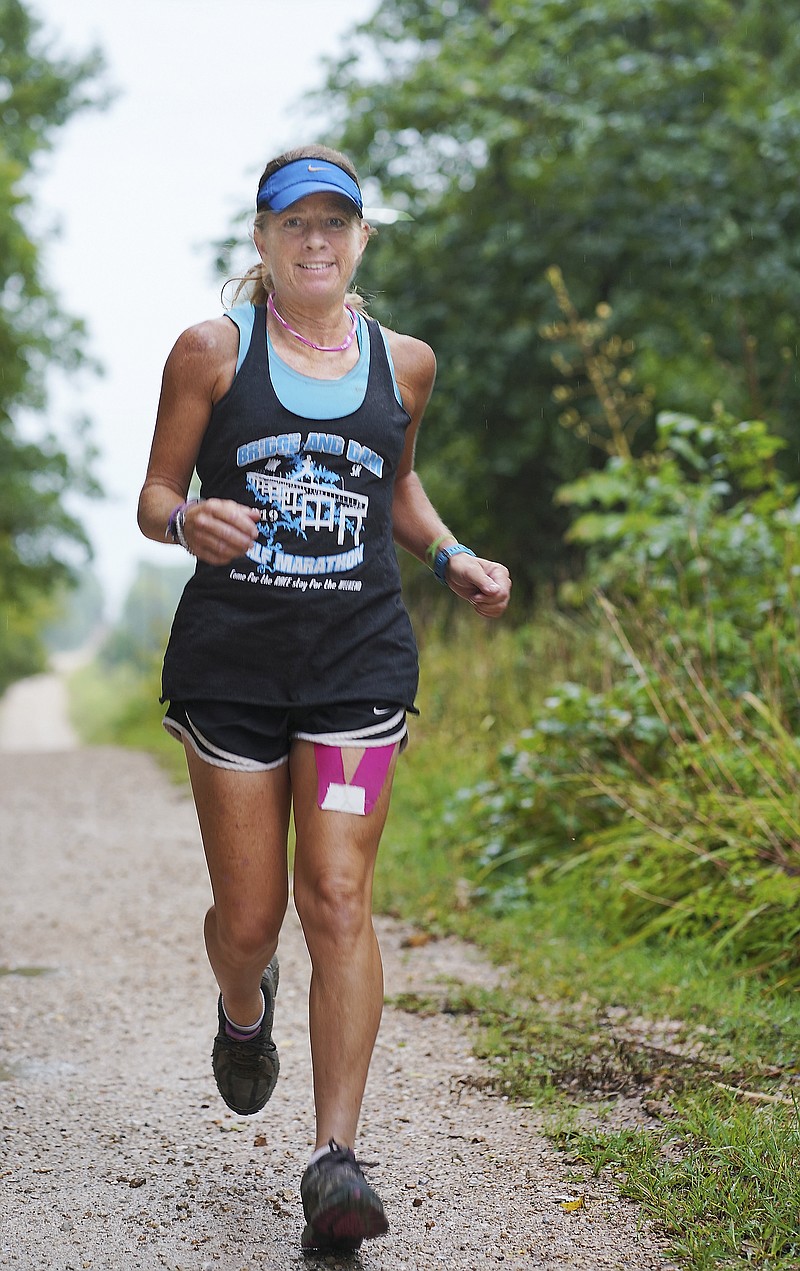Sometimes accompanied by her menagerie of rescued dogs, 52-year-old April Leonard runs the gravel roads surrounding Eldon. And as part of her training for marathons, she also runs the small city's streets.
"I have run every road in Eldon," Leonard said. "There are not a lot of roads in Eldon. I've run most of them back-and-forth several times to get in long runs."
When she's in shape and preparing for a marathon, she explained, she'll run about 5 miles a day (with days off) and conducts the occasional "fine tuning" run of 20 miles.
She ran through pain, especially in her left foot - much of which was caused by bunions.
"The bunion and the joint discomfort in my foot - from that - it made it difficult to put weight on my foot," Leonard said. "My gait changed a little bit. It was getting difficult to run."
She continued to live with the pain.
In 2017, she called Jefferson City Medical Group to schedule removal of calluses for her husband. While on hold, she listened to a description of a relatively new procedure the health care provider was offering - lapiplasty surgery, which repairs an unstable joint in the foot and corrects the bunion.
Caused by pressure on the big toe joint, bunions are painful, bony bumps that develop at the joint. The pressure forces the toe to lean toward the neighboring toe and causes a bump to appear on the edge of the toe nearest the other foot (on the inside of the foot).
It causes extra bone and a fluid-filled sac to develop at the base of the toe.
"I've been running full time for about 12 years," Leonard said. "(The pain) probably started in the summer of 2017. That's when the joint started to create some problems. I started getting some tendinitis in my ankle because of it."
All these years she'd been running, her feet had never bothered her, she said.
"Yes, they've been sore - and I've lost toenails and had things like that," Leonard said. "But they were typical things (for a runner)."
She didn't understand why there was a sudden change and thought tendinitis was responsible for the added pain.
Jody McAleer, a podiatrist at JCMG, ordered X-rays on the foot and came back with a diagnosis. Yes, she had bunions, but her arch was also collapsing.
He told her he'd worked on other athletes - runners, hockey players, ice skaters and professional dancers.
"You'll only become more uncomfortable as it gets worse over time. You might as well do it now," he told her.
Leonard chose to have several procedures done on her left foot.
Lapiplasty repairs the unstable joint, McAleer said Thursday. The traditional treatment - osteotomy - removes part of the bone.
Instead of cutting away the part of the bone that is misaligned, lapiplasty corrects deformities affecting the big toe: It realigns the bones.
"It is really in the realignment of the bones in three planes and dialing in the corrections," McAleer said. "You're restoring the person's natural anatomy."
The procedure uses titanium plates and screws to align the bone correctly.
If a doctor were to show you an X-ray of the repaired foot and covered the plates, you wouldn't be able to tell the repaired foot from an otherwise healthy foot, he said.
More than 30 percent of U.S. women have bunions. Most of the time, they choose to have the osteotomy, which shaves away part of the protruding bone but doesn't correct the underlying problem with the joint.
Recovery from osteotomy may take several months. And the bunion oftentimes recurs.
"I'm very excited about this surgery," Leonard said. "I've known several people who have their bunions operated on, and they've come back on them."
Recurrence only happens in about 3 percent of patients who receive lapiplasty, McAleer said.
"We're hoping all patients move toward this procedure," he said, "so we can fix these problems right the first time."
Recovery was slower for Leonard than other lapiplasty patients because of other procedures she had on her foot, she said.
She received the surgery in December 2017.
"It wasn't pretty. I had a little bit of recovery time," Leonard said. "And I went through some rehab, but I - relatively quickly - got back to normal activities."
Activities like feeding cows on her Eldon farm, where she had to work with the animals and slog through muddy barn lots.
She was able to begin running again in April 2018.
At the end of October 2018, she competed in a half-marathon.
Training continued.
Leonard got herself back up to running 30-40 miles per week before June, when she competed in a marathon in Anchorage, Alaska. A goal was to participate in the Anchorage Mayor's Marathon (to raise money for the Leukemia and Lymphoma Society) as part of a team honoring her brother, who is receiving treatment for lymphoma. She said the event raised nearly $500,000.
She continues to train so she has a chance to complete the "major six" marathons - including New York, Chicago, Berlin, London, Boston and Tokyo.
The only two she lacks are Tokyo and Boston.
The lapiplasty has given her a little more time to reach her goal, Leonard said.
She wishes the option would have been available 20 years ago, she said.
"I'm not as young as I used to be," Leonard said. "But I'm not as old as I will be. So I'm glad I did it now."

